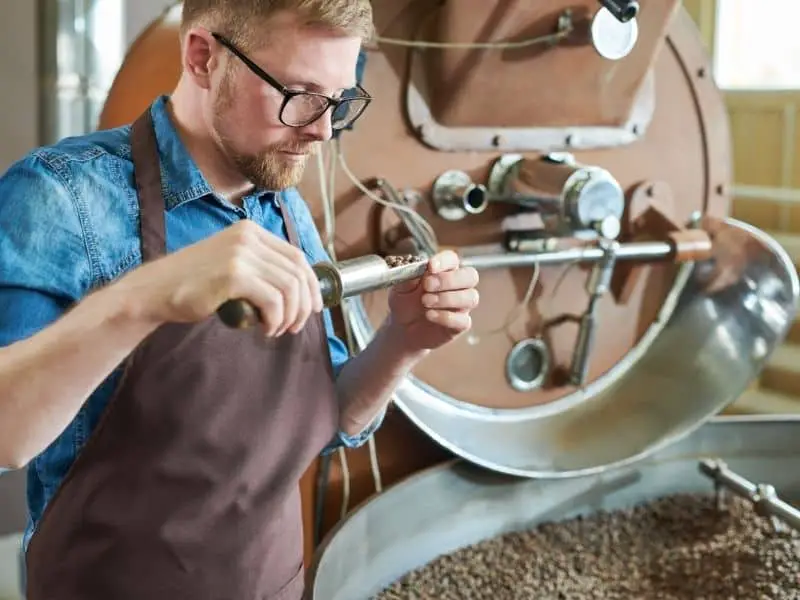When it comes to roasting coffee beans there are several different roasting styles, aimed at a certain level of taste and consistency.
There is a dark roast, medium roast, blonde roast, even a white roast, the first two of which are fairly self-explanatory.
But what is blonde roast coffee?
Let’s take a deeper look.
What is blonde roast coffee?
It seems to be a recent invention, but the style of the roast itself has been around since coffee first became popular.
It used to be called “cinnamon roast”, and in some cases “New England Roast”, and this often led to confusion among consumers – did it taste of cinnamon? Was it grown in New England? To simplify it and make it easier for the market, it was Starbucks that virtually branded it as Blonde Roast in 2012, which is why we tend to think of it as a recent creation.
It is simply a lighter roast than dark or medium (well who would have guessed that) meaning the beans are roasted for a shorter time, until the “first crack”.
The crack refers to the popping sound as beans are subject to the heat in the roasting process when moisture in the bean turns to steam and expands.

Is blonde roast coffee stronger?
When it comes to what we think of as the strength of a cup of coffee, we usually judge it on taste.
Blonde roast does not usually taste stronger than other roasts, in fact, it can taste lighter and smoother.
Not all of this is due to the roasting process as much as it is due to the bean selection.
For a blonde roast, beans from Latin America and East Africa are used, being lighter flavor beans to start with, rather than the heavy Sumatran or Indian beans.
Blonde roast coffee vs dark roast
Roasting is the process of forcing out the moisture from coffee beans and caramelizing the sugars.
Blonde roast beans, because they spend less time in the heat, retain more moisture, and tend to have more complex flavors, in terms of “brightness” or acidity, and hints of fruit and herbs.
They also taste “thinner” than dark or medium roasts, and a little sweeter.
Cooked at a lower temperature, blonde beans live up to their name and are light golden brown in color.
A dark roast has much less moisture and is less dense so they are actually lighter in terms of weight, and have less complex flavors. They have less acidity and have a fuller, stronger taste.
They are roasted for longer (until the “second crack”) at higher temperatures until almost black and are more oily. The longer beans are roasted, the more oil is drawn to the surface of the bean. This gives some of that strong flavor.
What does blonde roast coffee taste like?
From a technical viewpoint, whereas longer roasting breaks down the cell structure of the bean, a blonde roast emerges with cell structure intact.
This means you can taste more of the original bean, which has a complex fruity flavor and is even often described as “lemony”.
Being a lighter roast does not mean it tastes weaker than dark or medium roasts, but it is less bitter and smoother on the palate.
That makes it easier to drink black coffee without milk or sugar, especially as a short espresso.
Does blonde roast coffee have more caffeine?
Lighter roasts tend to be stronger in caffeine than darker or even medium roasts. This is because the longer they roast, the more the caffeine is “burned out” of the bean.
This can be difficult to judge. A light roast can contain up to 60% more caffeine by volume – when compared scoop for scoop. However, this is due to a darker bean being lighter and less dense.
By weight, comparing ounce by ounce, there is actually very little difference. In general, though we consume more caffeine with a blonde roast, simply because we usually use the same measurement as with other roasts.
For example, we put two scoops in the grinder, whether dark or light roast, we do not measure by weight.
This is common in cafes with modern espresso machines that automatically measure out a certain volume of beans to grind rather than the weight of the beans.
Final thoughts on blonde roast coffee
Blonde Roast coffee is simply a lighter roast than dark or medium meaning the beans are roasted for a shorter time, until the “first crack”.
More often than not, blonde roasts do not taste stronger than other roasts, but they can be smoother on your palate with hints of fruits.
It’s can also be a roast that’s easier to drink black, without adding milk or sugar.
When drinking a coffee with blonde roasted beans, you’ll more often than not be treated to a more caffeine-rich drink.
So, if you are looking for that morning buzz to wake you up, or if you study late at night and want to stay alert, a blonde roast will do the trick.
